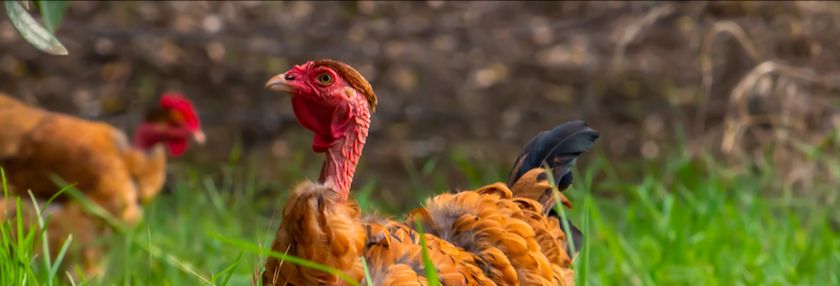Chicken a la Turkey?


Naked neck chickens, aka the Turken
It’s a turkey! It’s a chicken! It’s…a Turken! These oddballs of the chicken world have caused double-takes due to their stark lack of feathers on the head and neck – giving them the appearance of a small turkey.
Despite some popular beliefs, these quirky looking birds are not a hybrid of turkeys and chickens (this would be impossible, and the result would be sterile). They are bona fide chickens that sport a bare neck giving them a very unusual look indeed.
Also known as Naked Necks, Transylvanian Naked Necks, Kaalneks or Churkeys, Turkens are sweet, calm and friendly backyard pets that will definitely turn some heads.
Polarizing look
The very first thing you may think when you see a Turken is “Is that bird ok?” Ordinarily, a lack of feathers is indicative of mites, excessive pecking from flockmates, or another skin disease… but this is not the case for the lovely Turken. These birds naturally have very little or no feathers on the entirety of their neck. The tops of their heads may sport a tuft or toupee, but they are mostly featherless up top.
Turkens are stout birds with large breastbones, fanned tails, stately legs, a single red comb and pink skin. Their necks and head turn bright red in the sun. They also have less feathers over their entire body than most chickens due to their genetic mutation.
They are medium-sized with the hens reaching around 6 to 7 pounds. Turkens come in a variety of colors including black, white, buff ,and red.
History is in the genes
Where Turkens originated is confusing. Some historians claim these birds hail from Transylvania, whereas others insist they were first bred in Asia or Germany then brought to Transylvania where the breed was perfected. Wherever they came from, turkeys quickly gained popularity worldwide and have been recognized by the American Poultry Association since 1965.
The name came from their bare-necked resemblance to turkeys, as you may have guessed.

The nakedness of the neck is caused by a dominate genetic mutation that causes the overproduction of a feather-blocking molecule called BMP12.
BMP12 belongs to a group of proteins that inhibit the development of hair or feathers in animals. “Naked Neck” chickens have an extra block of DNA away from this mutation. It is activated to an unusually strong grade and prevents the growth of feathers on their head and neck.
They are dual-purpose birds who are popular with farmers, breeders and homesteaders for both their meat and egg production. Those raising them for meat especially love the fact that their scarcity of feathers makes them much easier to pluck.
A quiet personality
Turkens are very docile and make for wonderfully sweet backyard chickens. They are “in your pocket” birds who will happily follow their person around and may even jump in your lap if invited. These are the perfect chickens for beginners or children.
Turkens prefer to forage but also take confinement fairly well - so long as there is plenty of goodies to peck and scratch. They are not keen on flying or wandering, so they do not require any special coop amendments. They also tend to be rather quiet birds that prefer “muttering” over loud calls… which should make neighbors happy!
They fall into the middle of the pecking order and tend to keep to themselves. Hens can get grouchy with roosters, but are rather kind to the rest of the flock.
Health issues? Not really
Oddly, Turkens are known to be immune to most diseases, which make them very favorable for beginner coop-keepers. These hardy birds are very easy to care for and require no special care.
They have an average lifespan of 7-8 years.
This may come as a surprise (given their lack of feathers), but Turkens are amazingly cold hardy; they are known to happily peck and scratch on frozen ground, while their flockmates are huddled in the coop. They also do very well in heat; but, keep in mind their bare skin is susceptible to sunburns and they require shade to prevent sun damage.
Turkens are decent layers, producing between 120 to 180 medium, light brown eggs each year. They can be broody and make great mothers.
A quirky bird for backyards
Overall, Turkens are amazing and peculiar-looking birds for beginners or advanced chicken parents alike. Their curious appearance, robust nature and sweet personality make them a favorable addition to flocks of any size.
About the author
Shelby Stone is a writer and communications mechanic at Small Pet Select (shop.smallpetselect.com) when she isn’t busy with her chickens, her horse Percy, Mango the parrot, and the many other animals in her family.
A breeder explains it’s not a cross between two species: https://www.mcmurrayhatchery.com/turkens_naked_necks.html
The naked neck is just part of their charm
Tags:Chicken Chatter

Acreage Life is part of the Catalyst Communications Network publication family.














